BSBHRM602 - Strategic HRM Case Study: Walmart's HR Policies Analysis
VerifiedAdded on 2023/05/29
|31
|7946
|240
Case Study
AI Summary
This case study provides an in-depth analysis of Walmart's strategic human resource management (HRM) practices, focusing on how these practices align with the company's overall cost leadership strategy. It examines various HR policies, including recruitment, training, performance management, career management, compensation, employee benefits, and labor relations. The analysis highlights how Walmart integrates its HR functions to maintain a competitive advantage by minimizing employment costs and ensuring that employee behaviors support the company's strategic goals. The case study also explores instances of alleged violations of labor laws and discriminatory practices, as well as Walmart's approach to unionization, particularly in China. Ultimately, the study illustrates the contingency perspective of "best fit" in HRM, where HR practices are tailored to the specific context and strategic objectives of the organization. Desklib provides access to this and many other solved assignments and study resources.
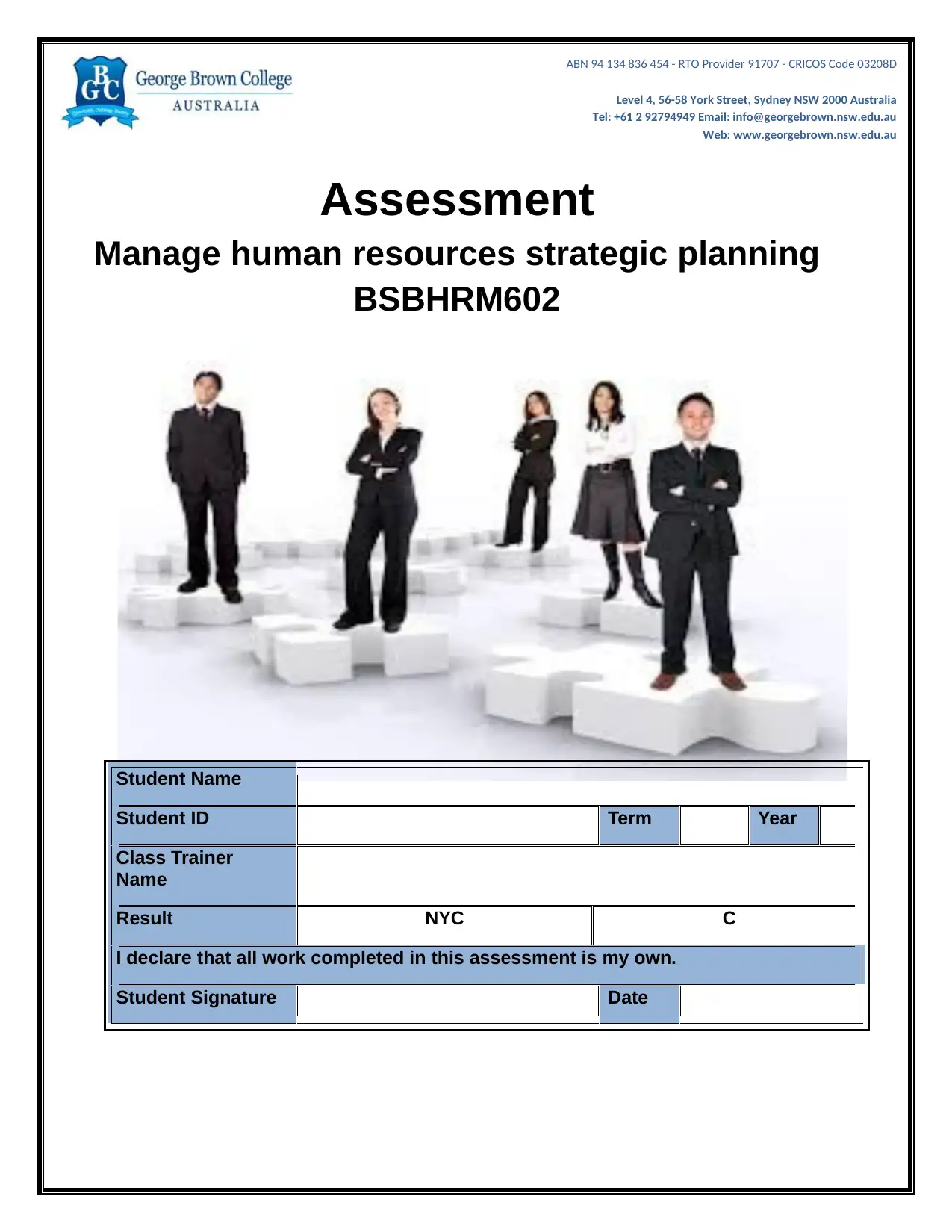
ABN 94 134 836 454 - RTO Provider 91707 - CRICOS Code 03208D
Level 4, 56-58 York Street, Sydney NSW 2000 Australia
Tel: +61 2 92794949 Email: info@georgebrown.nsw.edu.au
Web: www.georgebrown.nsw.edu.au
Assessment
Manage human resources strategic planning
BSBHRM602
Student Name
Student ID Term Year
Class Trainer
Name
Result NYC C
I declare that all work completed in this assessment is my own.
Student Signature Date
Level 4, 56-58 York Street, Sydney NSW 2000 Australia
Tel: +61 2 92794949 Email: info@georgebrown.nsw.edu.au
Web: www.georgebrown.nsw.edu.au
Assessment
Manage human resources strategic planning
BSBHRM602
Student Name
Student ID Term Year
Class Trainer
Name
Result NYC C
I declare that all work completed in this assessment is my own.
Student Signature Date
Paraphrase This Document
Need a fresh take? Get an instant paraphrase of this document with our AI Paraphraser
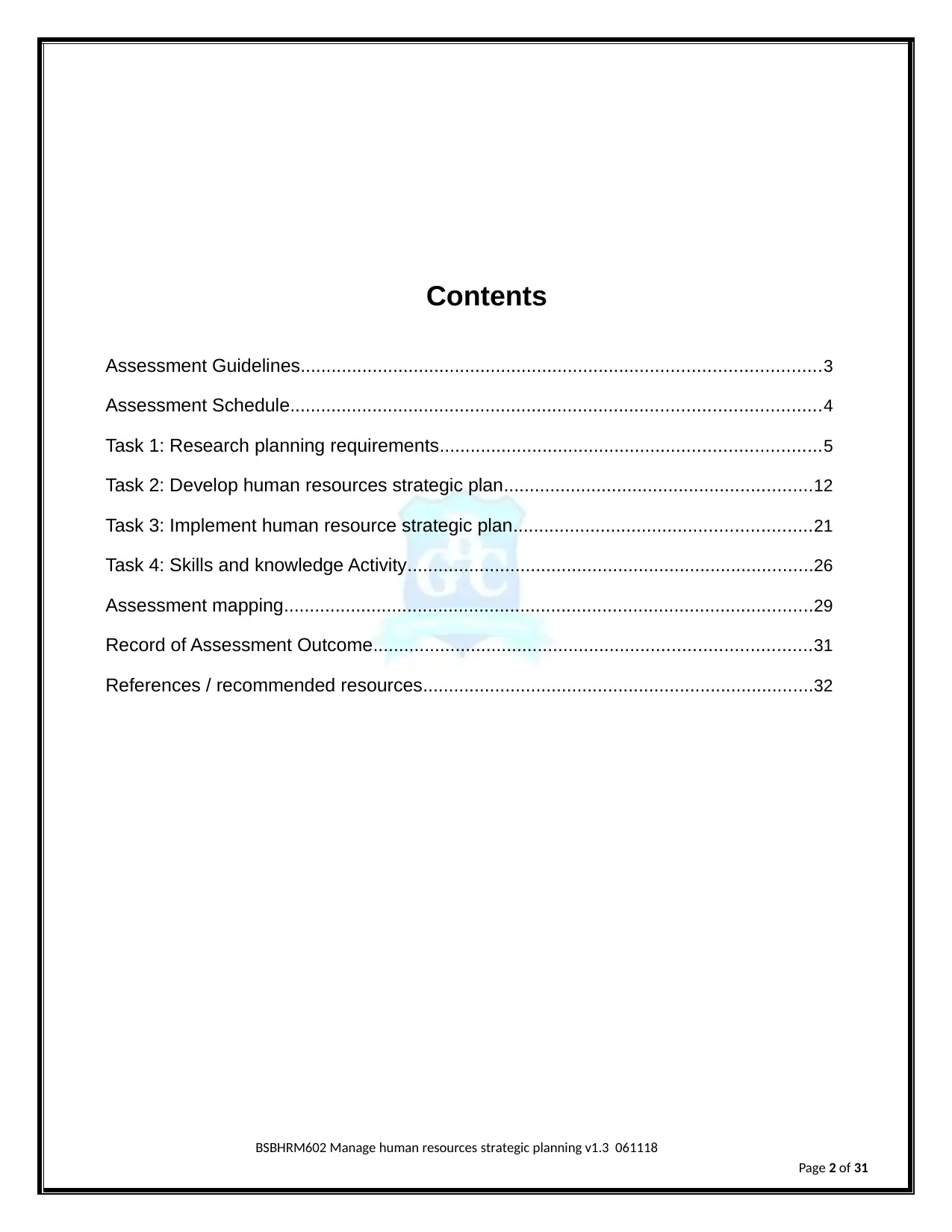
Contents
Assessment Guidelines.....................................................................................................3
Assessment Schedule.......................................................................................................4
Task 1: Research planning requirements..........................................................................5
Task 2: Develop human resources strategic plan............................................................12
Task 3: Implement human resource strategic plan..........................................................21
Task 4: Skills and knowledge Activity...............................................................................26
Assessment mapping.......................................................................................................29
Record of Assessment Outcome.....................................................................................31
References / recommended resources............................................................................32
BSBHRM602 Manage human resources strategic planning v1.3 061118
Page 2 of 31
Assessment Guidelines.....................................................................................................3
Assessment Schedule.......................................................................................................4
Task 1: Research planning requirements..........................................................................5
Task 2: Develop human resources strategic plan............................................................12
Task 3: Implement human resource strategic plan..........................................................21
Task 4: Skills and knowledge Activity...............................................................................26
Assessment mapping.......................................................................................................29
Record of Assessment Outcome.....................................................................................31
References / recommended resources............................................................................32
BSBHRM602 Manage human resources strategic planning v1.3 061118
Page 2 of 31
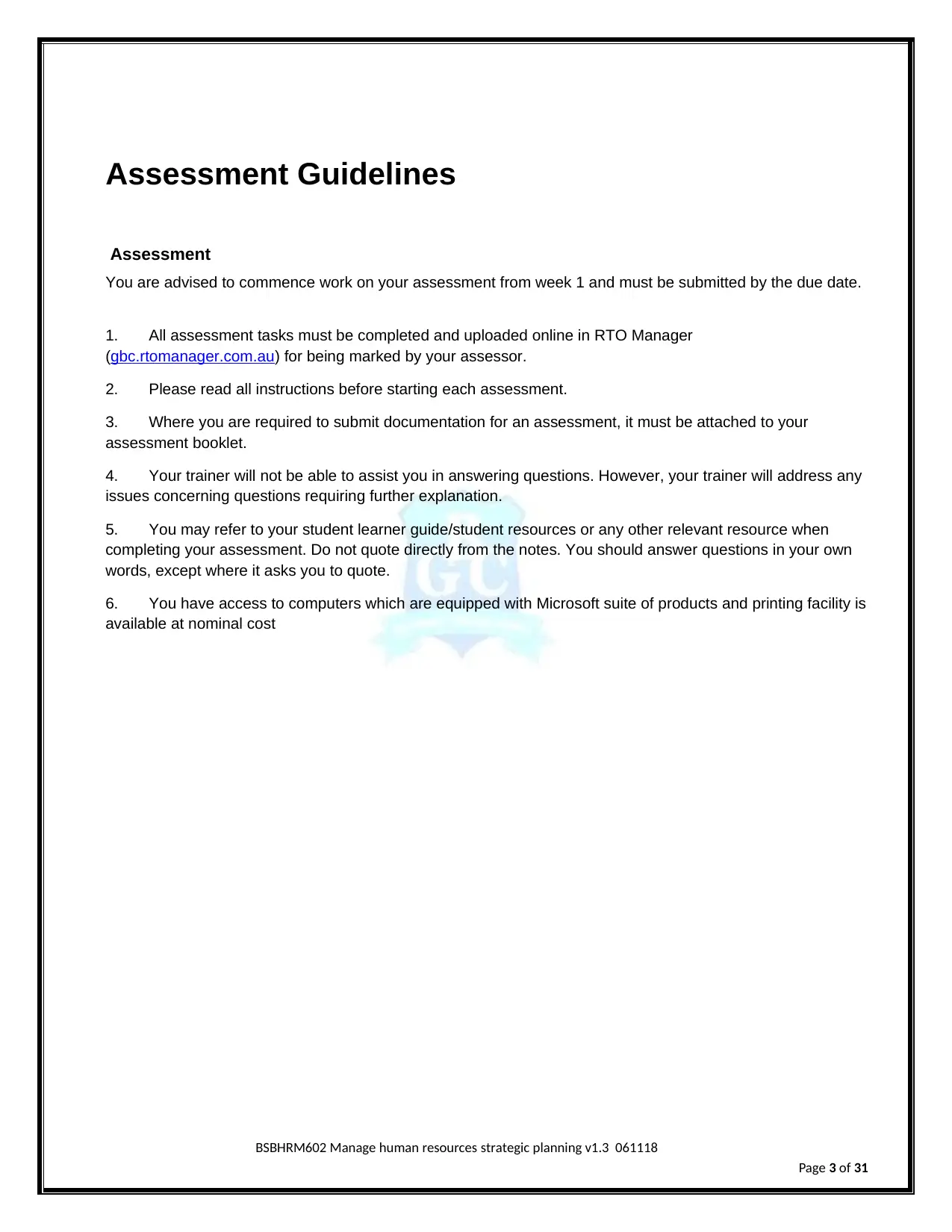
Assessment Guidelines
Assessment
You are advised to commence work on your assessment from week 1 and must be submitted by the due date.
1. All assessment tasks must be completed and uploaded online in RTO Manager
(gbc.rtomanager.com.au) for being marked by your assessor.
2. Please read all instructions before starting each assessment.
3. Where you are required to submit documentation for an assessment, it must be attached to your
assessment booklet.
4. Your trainer will not be able to assist you in answering questions. However, your trainer will address any
issues concerning questions requiring further explanation.
5. You may refer to your student learner guide/student resources or any other relevant resource when
completing your assessment. Do not quote directly from the notes. You should answer questions in your own
words, except where it asks you to quote.
6. You have access to computers which are equipped with Microsoft suite of products and printing facility is
available at nominal cost
BSBHRM602 Manage human resources strategic planning v1.3 061118
Page 3 of 31
Assessment
You are advised to commence work on your assessment from week 1 and must be submitted by the due date.
1. All assessment tasks must be completed and uploaded online in RTO Manager
(gbc.rtomanager.com.au) for being marked by your assessor.
2. Please read all instructions before starting each assessment.
3. Where you are required to submit documentation for an assessment, it must be attached to your
assessment booklet.
4. Your trainer will not be able to assist you in answering questions. However, your trainer will address any
issues concerning questions requiring further explanation.
5. You may refer to your student learner guide/student resources or any other relevant resource when
completing your assessment. Do not quote directly from the notes. You should answer questions in your own
words, except where it asks you to quote.
6. You have access to computers which are equipped with Microsoft suite of products and printing facility is
available at nominal cost
BSBHRM602 Manage human resources strategic planning v1.3 061118
Page 3 of 31
⊘ This is a preview!⊘
Do you want full access?
Subscribe today to unlock all pages.

Trusted by 1+ million students worldwide
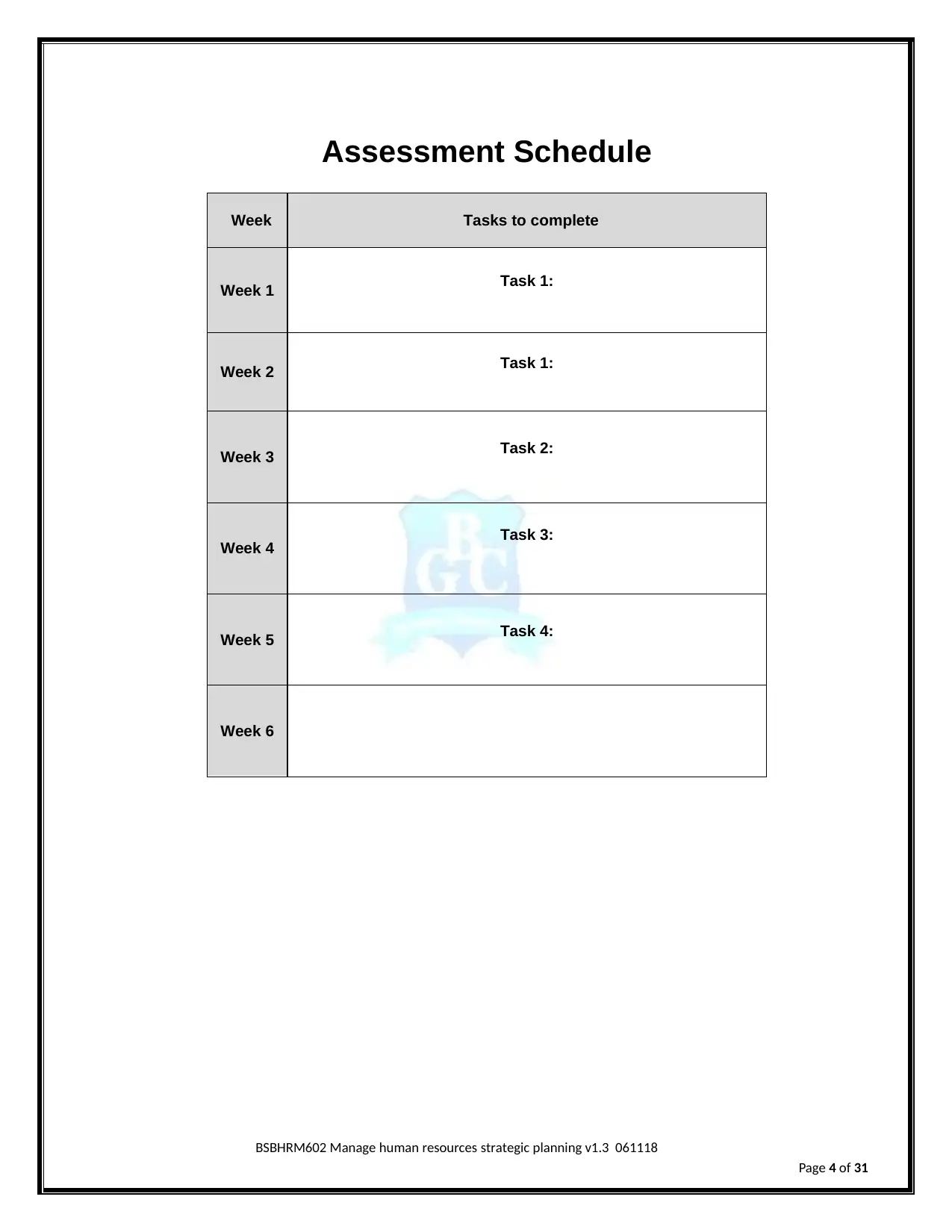
Assessment Schedule
Week Tasks to complete
Week 1 Task 1:
Week 2 Task 1:
Week 3 Task 2:
Week 4 Task 3:
Week 5 Task 4:
Week 6
BSBHRM602 Manage human resources strategic planning v1.3 061118
Page 4 of 31
Week Tasks to complete
Week 1 Task 1:
Week 2 Task 1:
Week 3 Task 2:
Week 4 Task 3:
Week 5 Task 4:
Week 6
BSBHRM602 Manage human resources strategic planning v1.3 061118
Page 4 of 31
Paraphrase This Document
Need a fresh take? Get an instant paraphrase of this document with our AI Paraphraser
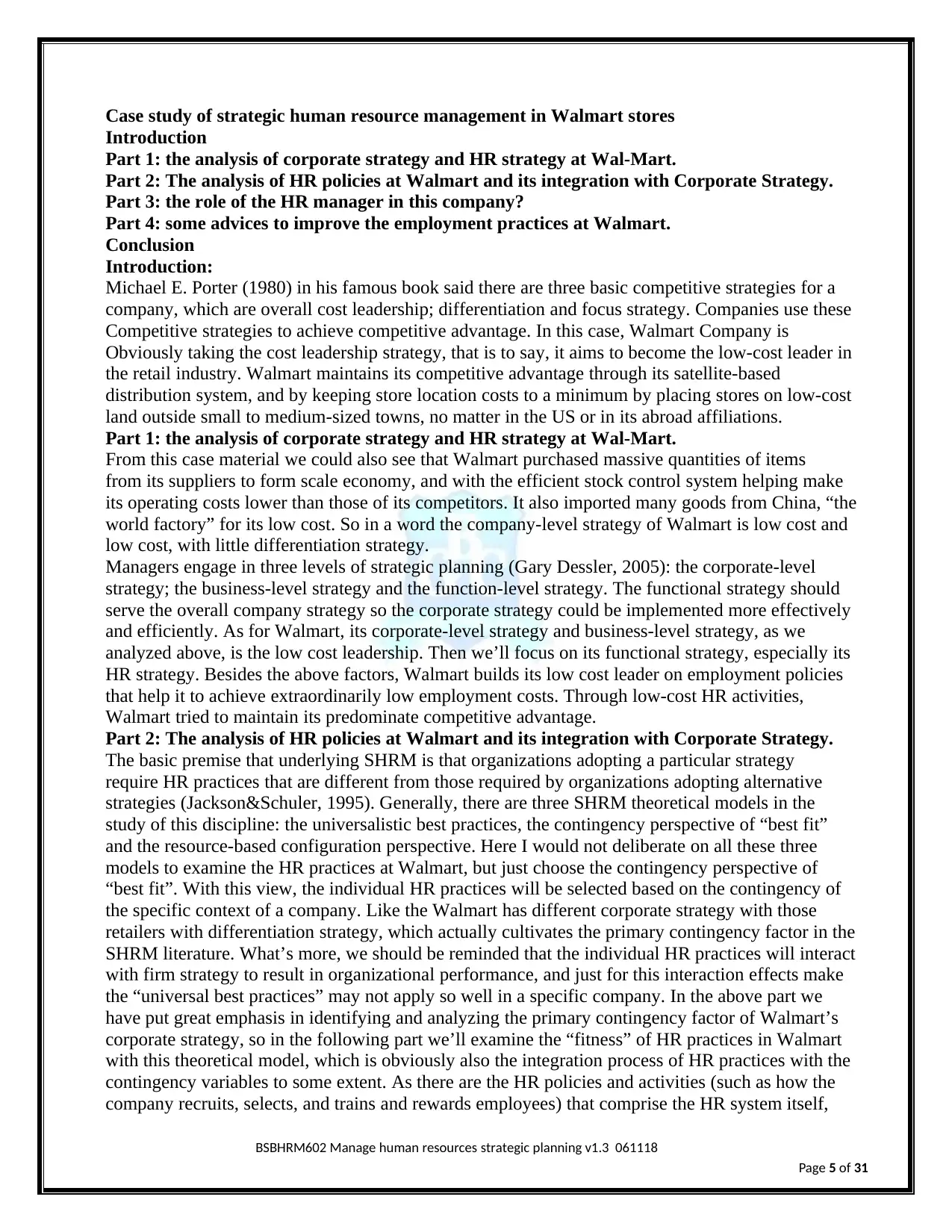
Case study of strategic human resource management in Walmart stores
Introduction
Part 1: the analysis of corporate strategy and HR strategy at Wal-Mart.
Part 2: The analysis of HR policies at Walmart and its integration with Corporate Strategy.
Part 3: the role of the HR manager in this company?
Part 4: some advices to improve the employment practices at Walmart.
Conclusion
Introduction:
Michael E. Porter (1980) in his famous book said there are three basic competitive strategies for a
company, which are overall cost leadership; differentiation and focus strategy. Companies use these
Competitive strategies to achieve competitive advantage. In this case, Walmart Company is
Obviously taking the cost leadership strategy, that is to say, it aims to become the low-cost leader in
the retail industry. Walmart maintains its competitive advantage through its satellite-based
distribution system, and by keeping store location costs to a minimum by placing stores on low-cost
land outside small to medium-sized towns, no matter in the US or in its abroad affiliations.
Part 1: the analysis of corporate strategy and HR strategy at Wal-Mart.
From this case material we could also see that Walmart purchased massive quantities of items
from its suppliers to form scale economy, and with the efficient stock control system helping make
its operating costs lower than those of its competitors. It also imported many goods from China, “the
world factory” for its low cost. So in a word the company-level strategy of Walmart is low cost and
low cost, with little differentiation strategy.
Managers engage in three levels of strategic planning (Gary Dessler, 2005): the corporate-level
strategy; the business-level strategy and the function-level strategy. The functional strategy should
serve the overall company strategy so the corporate strategy could be implemented more effectively
and efficiently. As for Walmart, its corporate-level strategy and business-level strategy, as we
analyzed above, is the low cost leadership. Then we’ll focus on its functional strategy, especially its
HR strategy. Besides the above factors, Walmart builds its low cost leader on employment policies
that help it to achieve extraordinarily low employment costs. Through low-cost HR activities,
Walmart tried to maintain its predominate competitive advantage.
Part 2: The analysis of HR policies at Walmart and its integration with Corporate Strategy.
The basic premise that underlying SHRM is that organizations adopting a particular strategy
require HR practices that are different from those required by organizations adopting alternative
strategies (Jackson&Schuler, 1995). Generally, there are three SHRM theoretical models in the
study of this discipline: the universalistic best practices, the contingency perspective of “best fit”
and the resource-based configuration perspective. Here I would not deliberate on all these three
models to examine the HR practices at Walmart, but just choose the contingency perspective of
“best fit”. With this view, the individual HR practices will be selected based on the contingency of
the specific context of a company. Like the Walmart has different corporate strategy with those
retailers with differentiation strategy, which actually cultivates the primary contingency factor in the
SHRM literature. What’s more, we should be reminded that the individual HR practices will interact
with firm strategy to result in organizational performance, and just for this interaction effects make
the “universal best practices” may not apply so well in a specific company. In the above part we
have put great emphasis in identifying and analyzing the primary contingency factor of Walmart’s
corporate strategy, so in the following part we’ll examine the “fitness” of HR practices in Walmart
with this theoretical model, which is obviously also the integration process of HR practices with the
contingency variables to some extent. As there are the HR policies and activities (such as how the
company recruits, selects, and trains and rewards employees) that comprise the HR system itself,
BSBHRM602 Manage human resources strategic planning v1.3 061118
Page 5 of 31
Introduction
Part 1: the analysis of corporate strategy and HR strategy at Wal-Mart.
Part 2: The analysis of HR policies at Walmart and its integration with Corporate Strategy.
Part 3: the role of the HR manager in this company?
Part 4: some advices to improve the employment practices at Walmart.
Conclusion
Introduction:
Michael E. Porter (1980) in his famous book said there are three basic competitive strategies for a
company, which are overall cost leadership; differentiation and focus strategy. Companies use these
Competitive strategies to achieve competitive advantage. In this case, Walmart Company is
Obviously taking the cost leadership strategy, that is to say, it aims to become the low-cost leader in
the retail industry. Walmart maintains its competitive advantage through its satellite-based
distribution system, and by keeping store location costs to a minimum by placing stores on low-cost
land outside small to medium-sized towns, no matter in the US or in its abroad affiliations.
Part 1: the analysis of corporate strategy and HR strategy at Wal-Mart.
From this case material we could also see that Walmart purchased massive quantities of items
from its suppliers to form scale economy, and with the efficient stock control system helping make
its operating costs lower than those of its competitors. It also imported many goods from China, “the
world factory” for its low cost. So in a word the company-level strategy of Walmart is low cost and
low cost, with little differentiation strategy.
Managers engage in three levels of strategic planning (Gary Dessler, 2005): the corporate-level
strategy; the business-level strategy and the function-level strategy. The functional strategy should
serve the overall company strategy so the corporate strategy could be implemented more effectively
and efficiently. As for Walmart, its corporate-level strategy and business-level strategy, as we
analyzed above, is the low cost leadership. Then we’ll focus on its functional strategy, especially its
HR strategy. Besides the above factors, Walmart builds its low cost leader on employment policies
that help it to achieve extraordinarily low employment costs. Through low-cost HR activities,
Walmart tried to maintain its predominate competitive advantage.
Part 2: The analysis of HR policies at Walmart and its integration with Corporate Strategy.
The basic premise that underlying SHRM is that organizations adopting a particular strategy
require HR practices that are different from those required by organizations adopting alternative
strategies (Jackson&Schuler, 1995). Generally, there are three SHRM theoretical models in the
study of this discipline: the universalistic best practices, the contingency perspective of “best fit”
and the resource-based configuration perspective. Here I would not deliberate on all these three
models to examine the HR practices at Walmart, but just choose the contingency perspective of
“best fit”. With this view, the individual HR practices will be selected based on the contingency of
the specific context of a company. Like the Walmart has different corporate strategy with those
retailers with differentiation strategy, which actually cultivates the primary contingency factor in the
SHRM literature. What’s more, we should be reminded that the individual HR practices will interact
with firm strategy to result in organizational performance, and just for this interaction effects make
the “universal best practices” may not apply so well in a specific company. In the above part we
have put great emphasis in identifying and analyzing the primary contingency factor of Walmart’s
corporate strategy, so in the following part we’ll examine the “fitness” of HR practices in Walmart
with this theoretical model, which is obviously also the integration process of HR practices with the
contingency variables to some extent. As there are the HR policies and activities (such as how the
company recruits, selects, and trains and rewards employees) that comprise the HR system itself,
BSBHRM602 Manage human resources strategic planning v1.3 061118
Page 5 of 31
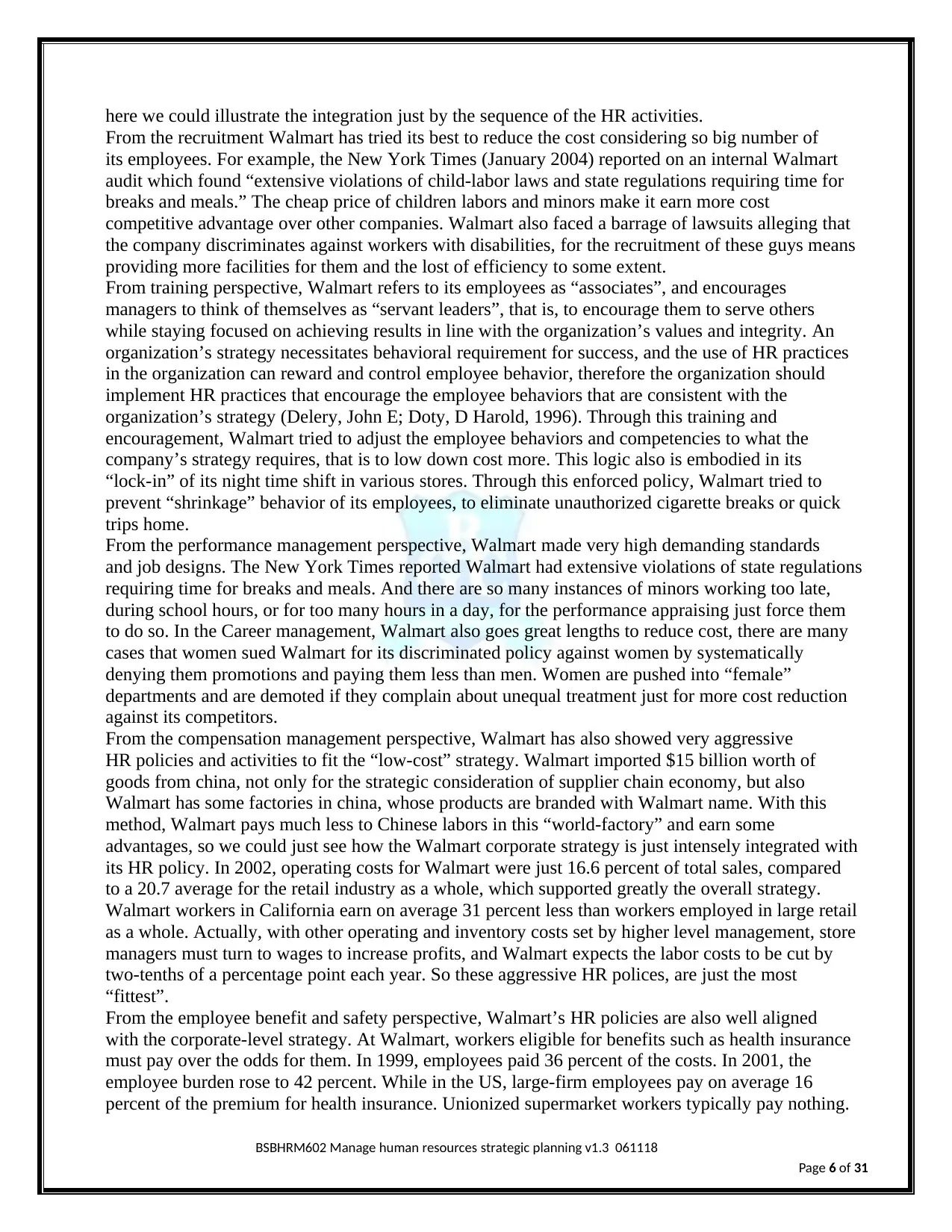
here we could illustrate the integration just by the sequence of the HR activities.
From the recruitment Walmart has tried its best to reduce the cost considering so big number of
its employees. For example, the New York Times (January 2004) reported on an internal Walmart
audit which found “extensive violations of child-labor laws and state regulations requiring time for
breaks and meals.” The cheap price of children labors and minors make it earn more cost
competitive advantage over other companies. Walmart also faced a barrage of lawsuits alleging that
the company discriminates against workers with disabilities, for the recruitment of these guys means
providing more facilities for them and the lost of efficiency to some extent.
From training perspective, Walmart refers to its employees as “associates”, and encourages
managers to think of themselves as “servant leaders”, that is, to encourage them to serve others
while staying focused on achieving results in line with the organization’s values and integrity. An
organization’s strategy necessitates behavioral requirement for success, and the use of HR practices
in the organization can reward and control employee behavior, therefore the organization should
implement HR practices that encourage the employee behaviors that are consistent with the
organization’s strategy (Delery, John E; Doty, D Harold, 1996). Through this training and
encouragement, Walmart tried to adjust the employee behaviors and competencies to what the
company’s strategy requires, that is to low down cost more. This logic also is embodied in its
“lock-in” of its night time shift in various stores. Through this enforced policy, Walmart tried to
prevent “shrinkage” behavior of its employees, to eliminate unauthorized cigarette breaks or quick
trips home.
From the performance management perspective, Walmart made very high demanding standards
and job designs. The New York Times reported Walmart had extensive violations of state regulations
requiring time for breaks and meals. And there are so many instances of minors working too late,
during school hours, or for too many hours in a day, for the performance appraising just force them
to do so. In the Career management, Walmart also goes great lengths to reduce cost, there are many
cases that women sued Walmart for its discriminated policy against women by systematically
denying them promotions and paying them less than men. Women are pushed into “female”
departments and are demoted if they complain about unequal treatment just for more cost reduction
against its competitors.
From the compensation management perspective, Walmart has also showed very aggressive
HR policies and activities to fit the “low-cost” strategy. Walmart imported $15 billion worth of
goods from china, not only for the strategic consideration of supplier chain economy, but also
Walmart has some factories in china, whose products are branded with Walmart name. With this
method, Walmart pays much less to Chinese labors in this “world-factory” and earn some
advantages, so we could just see how the Walmart corporate strategy is just intensely integrated with
its HR policy. In 2002, operating costs for Walmart were just 16.6 percent of total sales, compared
to a 20.7 average for the retail industry as a whole, which supported greatly the overall strategy.
Walmart workers in California earn on average 31 percent less than workers employed in large retail
as a whole. Actually, with other operating and inventory costs set by higher level management, store
managers must turn to wages to increase profits, and Walmart expects the labor costs to be cut by
two-tenths of a percentage point each year. So these aggressive HR polices, are just the most
“fittest”.
From the employee benefit and safety perspective, Walmart’s HR policies are also well aligned
with the corporate-level strategy. At Walmart, workers eligible for benefits such as health insurance
must pay over the odds for them. In 1999, employees paid 36 percent of the costs. In 2001, the
employee burden rose to 42 percent. While in the US, large-firm employees pay on average 16
percent of the premium for health insurance. Unionized supermarket workers typically pay nothing.
BSBHRM602 Manage human resources strategic planning v1.3 061118
Page 6 of 31
From the recruitment Walmart has tried its best to reduce the cost considering so big number of
its employees. For example, the New York Times (January 2004) reported on an internal Walmart
audit which found “extensive violations of child-labor laws and state regulations requiring time for
breaks and meals.” The cheap price of children labors and minors make it earn more cost
competitive advantage over other companies. Walmart also faced a barrage of lawsuits alleging that
the company discriminates against workers with disabilities, for the recruitment of these guys means
providing more facilities for them and the lost of efficiency to some extent.
From training perspective, Walmart refers to its employees as “associates”, and encourages
managers to think of themselves as “servant leaders”, that is, to encourage them to serve others
while staying focused on achieving results in line with the organization’s values and integrity. An
organization’s strategy necessitates behavioral requirement for success, and the use of HR practices
in the organization can reward and control employee behavior, therefore the organization should
implement HR practices that encourage the employee behaviors that are consistent with the
organization’s strategy (Delery, John E; Doty, D Harold, 1996). Through this training and
encouragement, Walmart tried to adjust the employee behaviors and competencies to what the
company’s strategy requires, that is to low down cost more. This logic also is embodied in its
“lock-in” of its night time shift in various stores. Through this enforced policy, Walmart tried to
prevent “shrinkage” behavior of its employees, to eliminate unauthorized cigarette breaks or quick
trips home.
From the performance management perspective, Walmart made very high demanding standards
and job designs. The New York Times reported Walmart had extensive violations of state regulations
requiring time for breaks and meals. And there are so many instances of minors working too late,
during school hours, or for too many hours in a day, for the performance appraising just force them
to do so. In the Career management, Walmart also goes great lengths to reduce cost, there are many
cases that women sued Walmart for its discriminated policy against women by systematically
denying them promotions and paying them less than men. Women are pushed into “female”
departments and are demoted if they complain about unequal treatment just for more cost reduction
against its competitors.
From the compensation management perspective, Walmart has also showed very aggressive
HR policies and activities to fit the “low-cost” strategy. Walmart imported $15 billion worth of
goods from china, not only for the strategic consideration of supplier chain economy, but also
Walmart has some factories in china, whose products are branded with Walmart name. With this
method, Walmart pays much less to Chinese labors in this “world-factory” and earn some
advantages, so we could just see how the Walmart corporate strategy is just intensely integrated with
its HR policy. In 2002, operating costs for Walmart were just 16.6 percent of total sales, compared
to a 20.7 average for the retail industry as a whole, which supported greatly the overall strategy.
Walmart workers in California earn on average 31 percent less than workers employed in large retail
as a whole. Actually, with other operating and inventory costs set by higher level management, store
managers must turn to wages to increase profits, and Walmart expects the labor costs to be cut by
two-tenths of a percentage point each year. So these aggressive HR polices, are just the most
“fittest”.
From the employee benefit and safety perspective, Walmart’s HR policies are also well aligned
with the corporate-level strategy. At Walmart, workers eligible for benefits such as health insurance
must pay over the odds for them. In 1999, employees paid 36 percent of the costs. In 2001, the
employee burden rose to 42 percent. While in the US, large-firm employees pay on average 16
percent of the premium for health insurance. Unionized supermarket workers typically pay nothing.
BSBHRM602 Manage human resources strategic planning v1.3 061118
Page 6 of 31
⊘ This is a preview!⊘
Do you want full access?
Subscribe today to unlock all pages.

Trusted by 1+ million students worldwide
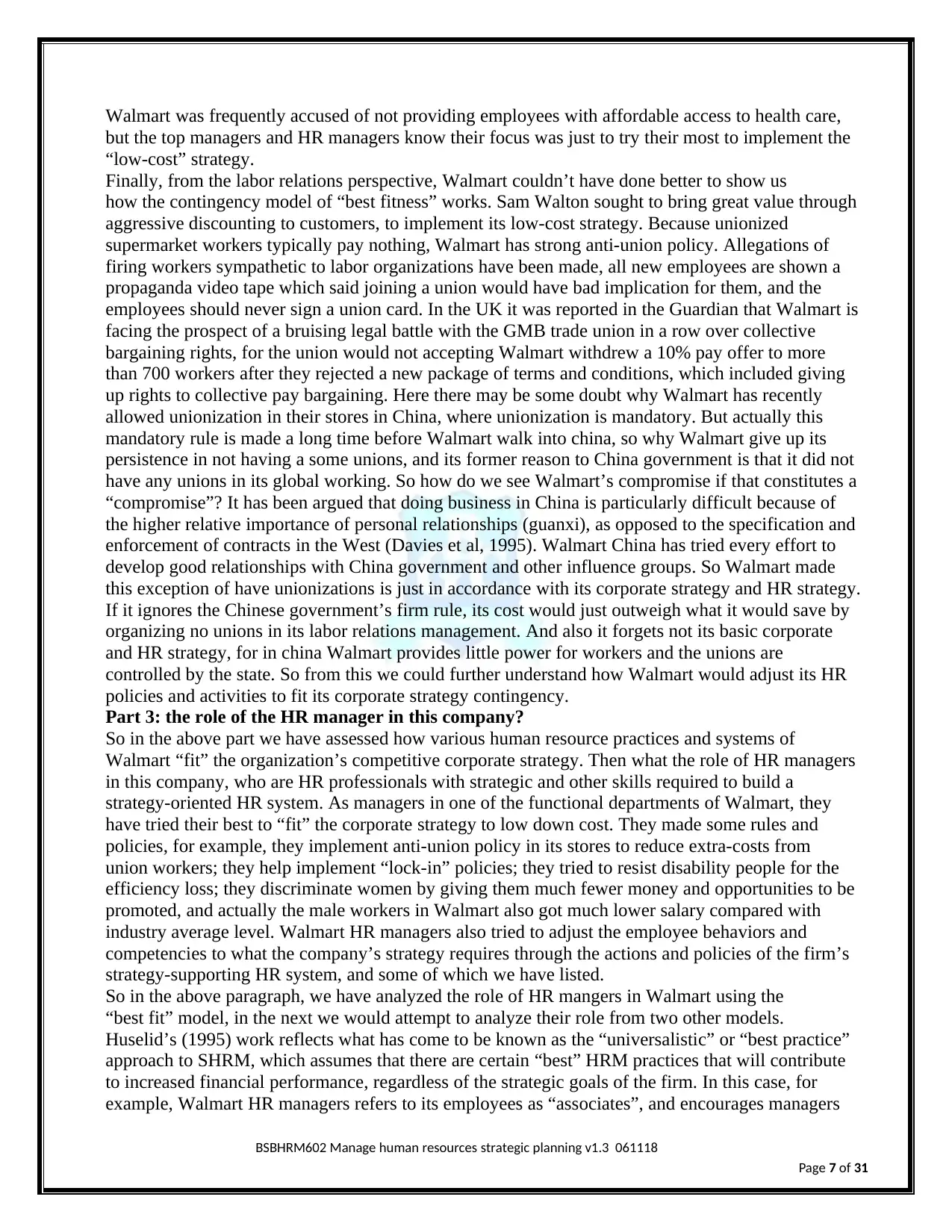
Walmart was frequently accused of not providing employees with affordable access to health care,
but the top managers and HR managers know their focus was just to try their most to implement the
“low-cost” strategy.
Finally, from the labor relations perspective, Walmart couldn’t have done better to show us
how the contingency model of “best fitness” works. Sam Walton sought to bring great value through
aggressive discounting to customers, to implement its low-cost strategy. Because unionized
supermarket workers typically pay nothing, Walmart has strong anti-union policy. Allegations of
firing workers sympathetic to labor organizations have been made, all new employees are shown a
propaganda video tape which said joining a union would have bad implication for them, and the
employees should never sign a union card. In the UK it was reported in the Guardian that Walmart is
facing the prospect of a bruising legal battle with the GMB trade union in a row over collective
bargaining rights, for the union would not accepting Walmart withdrew a 10% pay offer to more
than 700 workers after they rejected a new package of terms and conditions, which included giving
up rights to collective pay bargaining. Here there may be some doubt why Walmart has recently
allowed unionization in their stores in China, where unionization is mandatory. But actually this
mandatory rule is made a long time before Walmart walk into china, so why Walmart give up its
persistence in not having a some unions, and its former reason to China government is that it did not
have any unions in its global working. So how do we see Walmart’s compromise if that constitutes a
“compromise”? It has been argued that doing business in China is particularly difficult because of
the higher relative importance of personal relationships (guanxi), as opposed to the specification and
enforcement of contracts in the West (Davies et al, 1995). Walmart China has tried every effort to
develop good relationships with China government and other influence groups. So Walmart made
this exception of have unionizations is just in accordance with its corporate strategy and HR strategy.
If it ignores the Chinese government’s firm rule, its cost would just outweigh what it would save by
organizing no unions in its labor relations management. And also it forgets not its basic corporate
and HR strategy, for in china Walmart provides little power for workers and the unions are
controlled by the state. So from this we could further understand how Walmart would adjust its HR
policies and activities to fit its corporate strategy contingency.
Part 3: the role of the HR manager in this company?
So in the above part we have assessed how various human resource practices and systems of
Walmart “fit” the organization’s competitive corporate strategy. Then what the role of HR managers
in this company, who are HR professionals with strategic and other skills required to build a
strategy-oriented HR system. As managers in one of the functional departments of Walmart, they
have tried their best to “fit” the corporate strategy to low down cost. They made some rules and
policies, for example, they implement anti-union policy in its stores to reduce extra-costs from
union workers; they help implement “lock-in” policies; they tried to resist disability people for the
efficiency loss; they discriminate women by giving them much fewer money and opportunities to be
promoted, and actually the male workers in Walmart also got much lower salary compared with
industry average level. Walmart HR managers also tried to adjust the employee behaviors and
competencies to what the company’s strategy requires through the actions and policies of the firm’s
strategy-supporting HR system, and some of which we have listed.
So in the above paragraph, we have analyzed the role of HR mangers in Walmart using the
“best fit” model, in the next we would attempt to analyze their role from two other models.
Huselid’s (1995) work reflects what has come to be known as the “universalistic” or “best practice”
approach to SHRM, which assumes that there are certain “best” HRM practices that will contribute
to increased financial performance, regardless of the strategic goals of the firm. In this case, for
example, Walmart HR managers refers to its employees as “associates”, and encourages managers
BSBHRM602 Manage human resources strategic planning v1.3 061118
Page 7 of 31
but the top managers and HR managers know their focus was just to try their most to implement the
“low-cost” strategy.
Finally, from the labor relations perspective, Walmart couldn’t have done better to show us
how the contingency model of “best fitness” works. Sam Walton sought to bring great value through
aggressive discounting to customers, to implement its low-cost strategy. Because unionized
supermarket workers typically pay nothing, Walmart has strong anti-union policy. Allegations of
firing workers sympathetic to labor organizations have been made, all new employees are shown a
propaganda video tape which said joining a union would have bad implication for them, and the
employees should never sign a union card. In the UK it was reported in the Guardian that Walmart is
facing the prospect of a bruising legal battle with the GMB trade union in a row over collective
bargaining rights, for the union would not accepting Walmart withdrew a 10% pay offer to more
than 700 workers after they rejected a new package of terms and conditions, which included giving
up rights to collective pay bargaining. Here there may be some doubt why Walmart has recently
allowed unionization in their stores in China, where unionization is mandatory. But actually this
mandatory rule is made a long time before Walmart walk into china, so why Walmart give up its
persistence in not having a some unions, and its former reason to China government is that it did not
have any unions in its global working. So how do we see Walmart’s compromise if that constitutes a
“compromise”? It has been argued that doing business in China is particularly difficult because of
the higher relative importance of personal relationships (guanxi), as opposed to the specification and
enforcement of contracts in the West (Davies et al, 1995). Walmart China has tried every effort to
develop good relationships with China government and other influence groups. So Walmart made
this exception of have unionizations is just in accordance with its corporate strategy and HR strategy.
If it ignores the Chinese government’s firm rule, its cost would just outweigh what it would save by
organizing no unions in its labor relations management. And also it forgets not its basic corporate
and HR strategy, for in china Walmart provides little power for workers and the unions are
controlled by the state. So from this we could further understand how Walmart would adjust its HR
policies and activities to fit its corporate strategy contingency.
Part 3: the role of the HR manager in this company?
So in the above part we have assessed how various human resource practices and systems of
Walmart “fit” the organization’s competitive corporate strategy. Then what the role of HR managers
in this company, who are HR professionals with strategic and other skills required to build a
strategy-oriented HR system. As managers in one of the functional departments of Walmart, they
have tried their best to “fit” the corporate strategy to low down cost. They made some rules and
policies, for example, they implement anti-union policy in its stores to reduce extra-costs from
union workers; they help implement “lock-in” policies; they tried to resist disability people for the
efficiency loss; they discriminate women by giving them much fewer money and opportunities to be
promoted, and actually the male workers in Walmart also got much lower salary compared with
industry average level. Walmart HR managers also tried to adjust the employee behaviors and
competencies to what the company’s strategy requires through the actions and policies of the firm’s
strategy-supporting HR system, and some of which we have listed.
So in the above paragraph, we have analyzed the role of HR mangers in Walmart using the
“best fit” model, in the next we would attempt to analyze their role from two other models.
Huselid’s (1995) work reflects what has come to be known as the “universalistic” or “best practice”
approach to SHRM, which assumes that there are certain “best” HRM practices that will contribute
to increased financial performance, regardless of the strategic goals of the firm. In this case, for
example, Walmart HR managers refers to its employees as “associates”, and encourages managers
BSBHRM602 Manage human resources strategic planning v1.3 061118
Page 7 of 31
Paraphrase This Document
Need a fresh take? Get an instant paraphrase of this document with our AI Paraphraser
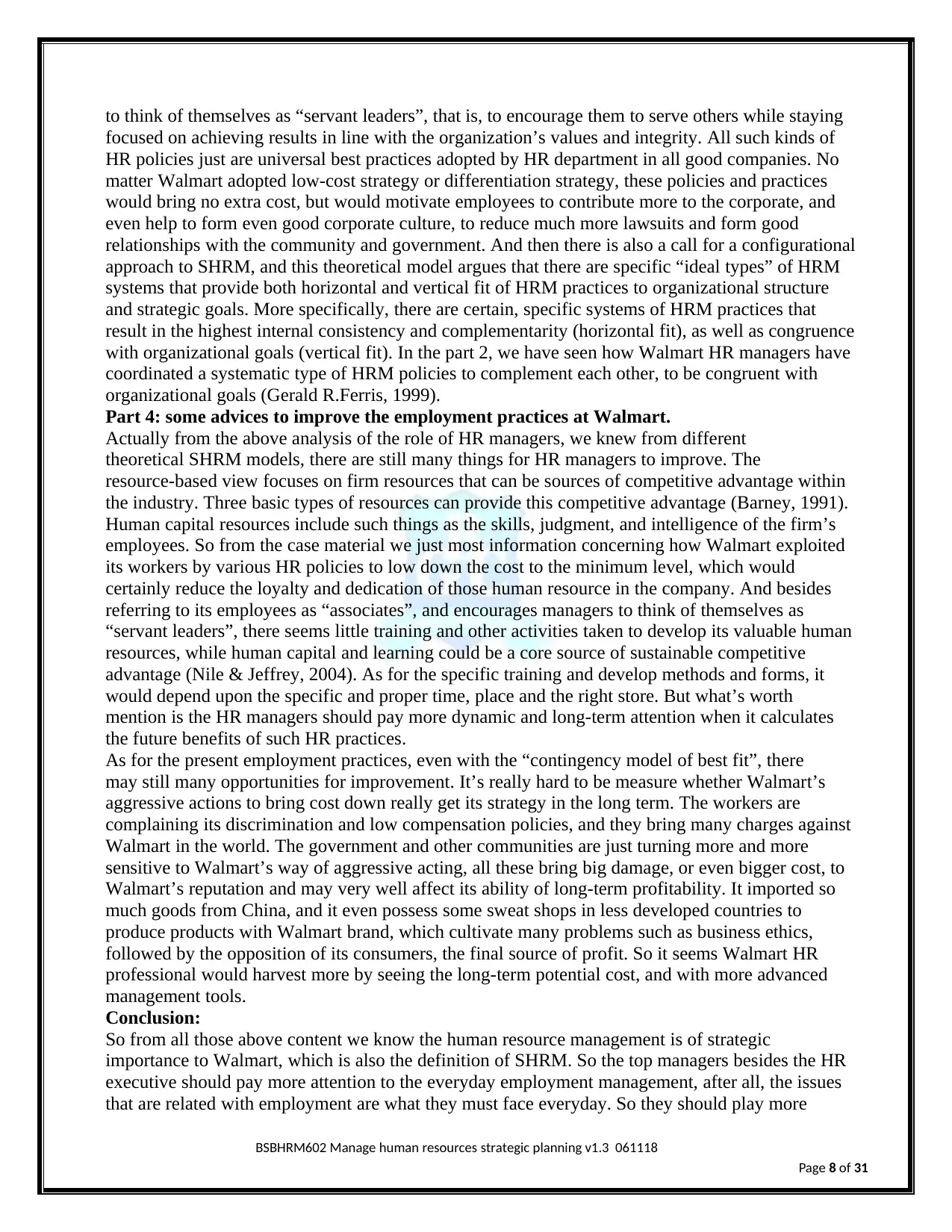
to think of themselves as “servant leaders”, that is, to encourage them to serve others while staying
focused on achieving results in line with the organization’s values and integrity. All such kinds of
HR policies just are universal best practices adopted by HR department in all good companies. No
matter Walmart adopted low-cost strategy or differentiation strategy, these policies and practices
would bring no extra cost, but would motivate employees to contribute more to the corporate, and
even help to form even good corporate culture, to reduce much more lawsuits and form good
relationships with the community and government. And then there is also a call for a configurational
approach to SHRM, and this theoretical model argues that there are specific “ideal types” of HRM
systems that provide both horizontal and vertical fit of HRM practices to organizational structure
and strategic goals. More specifically, there are certain, specific systems of HRM practices that
result in the highest internal consistency and complementarity (horizontal fit), as well as congruence
with organizational goals (vertical fit). In the part 2, we have seen how Walmart HR managers have
coordinated a systematic type of HRM policies to complement each other, to be congruent with
organizational goals (Gerald R.Ferris, 1999).
Part 4: some advices to improve the employment practices at Walmart.
Actually from the above analysis of the role of HR managers, we knew from different
theoretical SHRM models, there are still many things for HR managers to improve. The
resource-based view focuses on firm resources that can be sources of competitive advantage within
the industry. Three basic types of resources can provide this competitive advantage (Barney, 1991).
Human capital resources include such things as the skills, judgment, and intelligence of the firm’s
employees. So from the case material we just most information concerning how Walmart exploited
its workers by various HR policies to low down the cost to the minimum level, which would
certainly reduce the loyalty and dedication of those human resource in the company. And besides
referring to its employees as “associates”, and encourages managers to think of themselves as
“servant leaders”, there seems little training and other activities taken to develop its valuable human
resources, while human capital and learning could be a core source of sustainable competitive
advantage (Nile & Jeffrey, 2004). As for the specific training and develop methods and forms, it
would depend upon the specific and proper time, place and the right store. But what’s worth
mention is the HR managers should pay more dynamic and long-term attention when it calculates
the future benefits of such HR practices.
As for the present employment practices, even with the “contingency model of best fit”, there
may still many opportunities for improvement. It’s really hard to be measure whether Walmart’s
aggressive actions to bring cost down really get its strategy in the long term. The workers are
complaining its discrimination and low compensation policies, and they bring many charges against
Walmart in the world. The government and other communities are just turning more and more
sensitive to Walmart’s way of aggressive acting, all these bring big damage, or even bigger cost, to
Walmart’s reputation and may very well affect its ability of long-term profitability. It imported so
much goods from China, and it even possess some sweat shops in less developed countries to
produce products with Walmart brand, which cultivate many problems such as business ethics,
followed by the opposition of its consumers, the final source of profit. So it seems Walmart HR
professional would harvest more by seeing the long-term potential cost, and with more advanced
management tools.
Conclusion:
So from all those above content we know the human resource management is of strategic
importance to Walmart, which is also the definition of SHRM. So the top managers besides the HR
executive should pay more attention to the everyday employment management, after all, the issues
that are related with employment are what they must face everyday. So they should play more
BSBHRM602 Manage human resources strategic planning v1.3 061118
Page 8 of 31
focused on achieving results in line with the organization’s values and integrity. All such kinds of
HR policies just are universal best practices adopted by HR department in all good companies. No
matter Walmart adopted low-cost strategy or differentiation strategy, these policies and practices
would bring no extra cost, but would motivate employees to contribute more to the corporate, and
even help to form even good corporate culture, to reduce much more lawsuits and form good
relationships with the community and government. And then there is also a call for a configurational
approach to SHRM, and this theoretical model argues that there are specific “ideal types” of HRM
systems that provide both horizontal and vertical fit of HRM practices to organizational structure
and strategic goals. More specifically, there are certain, specific systems of HRM practices that
result in the highest internal consistency and complementarity (horizontal fit), as well as congruence
with organizational goals (vertical fit). In the part 2, we have seen how Walmart HR managers have
coordinated a systematic type of HRM policies to complement each other, to be congruent with
organizational goals (Gerald R.Ferris, 1999).
Part 4: some advices to improve the employment practices at Walmart.
Actually from the above analysis of the role of HR managers, we knew from different
theoretical SHRM models, there are still many things for HR managers to improve. The
resource-based view focuses on firm resources that can be sources of competitive advantage within
the industry. Three basic types of resources can provide this competitive advantage (Barney, 1991).
Human capital resources include such things as the skills, judgment, and intelligence of the firm’s
employees. So from the case material we just most information concerning how Walmart exploited
its workers by various HR policies to low down the cost to the minimum level, which would
certainly reduce the loyalty and dedication of those human resource in the company. And besides
referring to its employees as “associates”, and encourages managers to think of themselves as
“servant leaders”, there seems little training and other activities taken to develop its valuable human
resources, while human capital and learning could be a core source of sustainable competitive
advantage (Nile & Jeffrey, 2004). As for the specific training and develop methods and forms, it
would depend upon the specific and proper time, place and the right store. But what’s worth
mention is the HR managers should pay more dynamic and long-term attention when it calculates
the future benefits of such HR practices.
As for the present employment practices, even with the “contingency model of best fit”, there
may still many opportunities for improvement. It’s really hard to be measure whether Walmart’s
aggressive actions to bring cost down really get its strategy in the long term. The workers are
complaining its discrimination and low compensation policies, and they bring many charges against
Walmart in the world. The government and other communities are just turning more and more
sensitive to Walmart’s way of aggressive acting, all these bring big damage, or even bigger cost, to
Walmart’s reputation and may very well affect its ability of long-term profitability. It imported so
much goods from China, and it even possess some sweat shops in less developed countries to
produce products with Walmart brand, which cultivate many problems such as business ethics,
followed by the opposition of its consumers, the final source of profit. So it seems Walmart HR
professional would harvest more by seeing the long-term potential cost, and with more advanced
management tools.
Conclusion:
So from all those above content we know the human resource management is of strategic
importance to Walmart, which is also the definition of SHRM. So the top managers besides the HR
executive should pay more attention to the everyday employment management, after all, the issues
that are related with employment are what they must face everyday. So they should play more
BSBHRM602 Manage human resources strategic planning v1.3 061118
Page 8 of 31
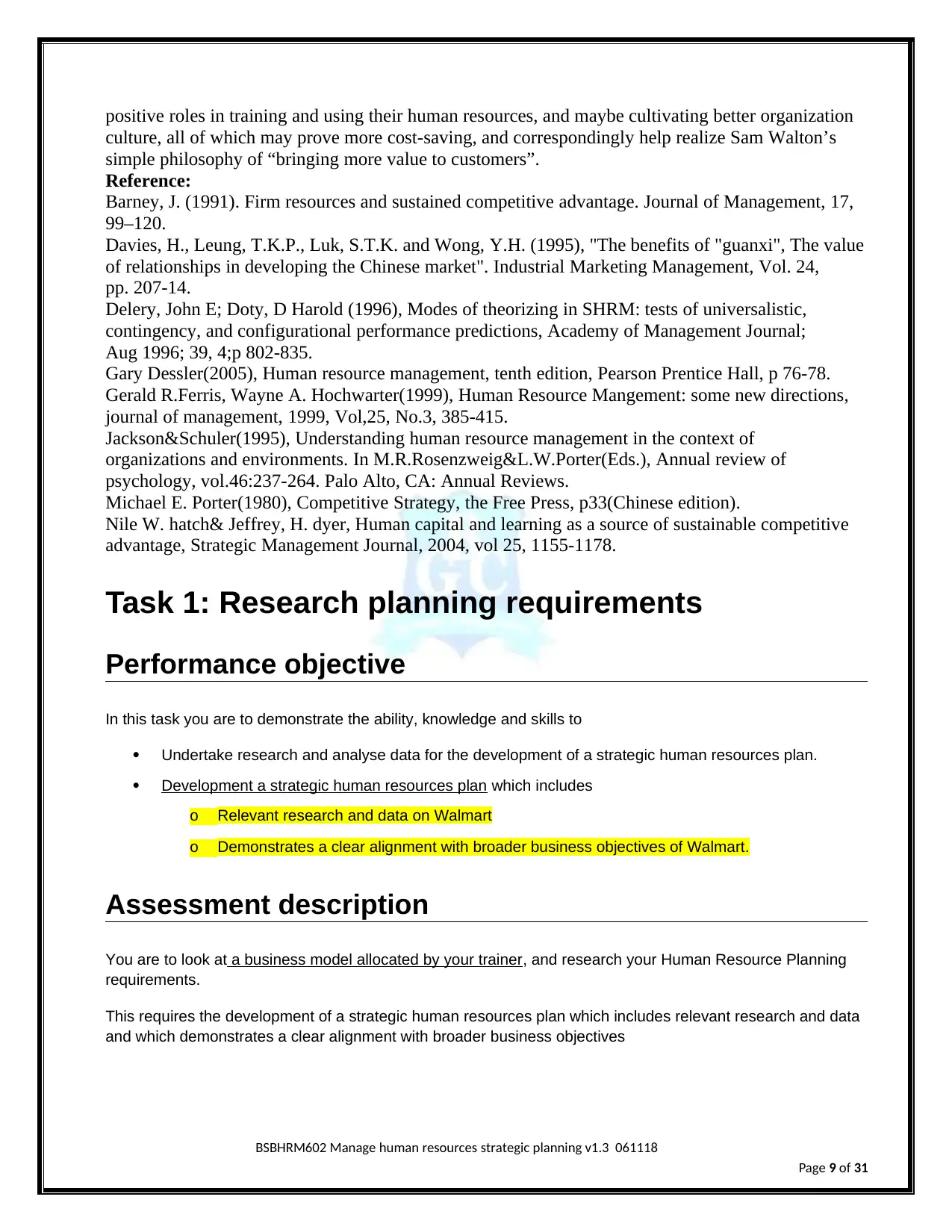
positive roles in training and using their human resources, and maybe cultivating better organization
culture, all of which may prove more cost-saving, and correspondingly help realize Sam Walton’s
simple philosophy of “bringing more value to customers”.
Reference:
Barney, J. (1991). Firm resources and sustained competitive advantage. Journal of Management, 17,
99–120.
Davies, H., Leung, T.K.P., Luk, S.T.K. and Wong, Y.H. (1995), "The benefits of "guanxi", The value
of relationships in developing the Chinese market". Industrial Marketing Management, Vol. 24,
pp. 207-14.
Delery, John E; Doty, D Harold (1996), Modes of theorizing in SHRM: tests of universalistic,
contingency, and configurational performance predictions, Academy of Management Journal;
Aug 1996; 39, 4;p 802-835.
Gary Dessler(2005), Human resource management, tenth edition, Pearson Prentice Hall, p 76-78.
Gerald R.Ferris, Wayne A. Hochwarter(1999), Human Resource Mangement: some new directions,
journal of management, 1999, Vol,25, No.3, 385-415.
Jackson&Schuler(1995), Understanding human resource management in the context of
organizations and environments. In M.R.Rosenzweig&L.W.Porter(Eds.), Annual review of
psychology, vol.46:237-264. Palo Alto, CA: Annual Reviews.
Michael E. Porter(1980), Competitive Strategy, the Free Press, p33(Chinese edition).
Nile W. hatch& Jeffrey, H. dyer, Human capital and learning as a source of sustainable competitive
advantage, Strategic Management Journal, 2004, vol 25, 1155-1178.
Task 1: Research planning requirements
Performance objective
In this task you are to demonstrate the ability, knowledge and skills to
Undertake research and analyse data for the development of a strategic human resources plan.
Development a strategic human resources plan which includes
o Relevant research and data on Walmart
o Demonstrates a clear alignment with broader business objectives of Walmart.
Assessment description
You are to look at a business model allocated by your trainer, and research your Human Resource Planning
requirements.
This requires the development of a strategic human resources plan which includes relevant research and data
and which demonstrates a clear alignment with broader business objectives
BSBHRM602 Manage human resources strategic planning v1.3 061118
Page 9 of 31
culture, all of which may prove more cost-saving, and correspondingly help realize Sam Walton’s
simple philosophy of “bringing more value to customers”.
Reference:
Barney, J. (1991). Firm resources and sustained competitive advantage. Journal of Management, 17,
99–120.
Davies, H., Leung, T.K.P., Luk, S.T.K. and Wong, Y.H. (1995), "The benefits of "guanxi", The value
of relationships in developing the Chinese market". Industrial Marketing Management, Vol. 24,
pp. 207-14.
Delery, John E; Doty, D Harold (1996), Modes of theorizing in SHRM: tests of universalistic,
contingency, and configurational performance predictions, Academy of Management Journal;
Aug 1996; 39, 4;p 802-835.
Gary Dessler(2005), Human resource management, tenth edition, Pearson Prentice Hall, p 76-78.
Gerald R.Ferris, Wayne A. Hochwarter(1999), Human Resource Mangement: some new directions,
journal of management, 1999, Vol,25, No.3, 385-415.
Jackson&Schuler(1995), Understanding human resource management in the context of
organizations and environments. In M.R.Rosenzweig&L.W.Porter(Eds.), Annual review of
psychology, vol.46:237-264. Palo Alto, CA: Annual Reviews.
Michael E. Porter(1980), Competitive Strategy, the Free Press, p33(Chinese edition).
Nile W. hatch& Jeffrey, H. dyer, Human capital and learning as a source of sustainable competitive
advantage, Strategic Management Journal, 2004, vol 25, 1155-1178.
Task 1: Research planning requirements
Performance objective
In this task you are to demonstrate the ability, knowledge and skills to
Undertake research and analyse data for the development of a strategic human resources plan.
Development a strategic human resources plan which includes
o Relevant research and data on Walmart
o Demonstrates a clear alignment with broader business objectives of Walmart.
Assessment description
You are to look at a business model allocated by your trainer, and research your Human Resource Planning
requirements.
This requires the development of a strategic human resources plan which includes relevant research and data
and which demonstrates a clear alignment with broader business objectives
BSBHRM602 Manage human resources strategic planning v1.3 061118
Page 9 of 31
⊘ This is a preview!⊘
Do you want full access?
Subscribe today to unlock all pages.

Trusted by 1+ million students worldwide
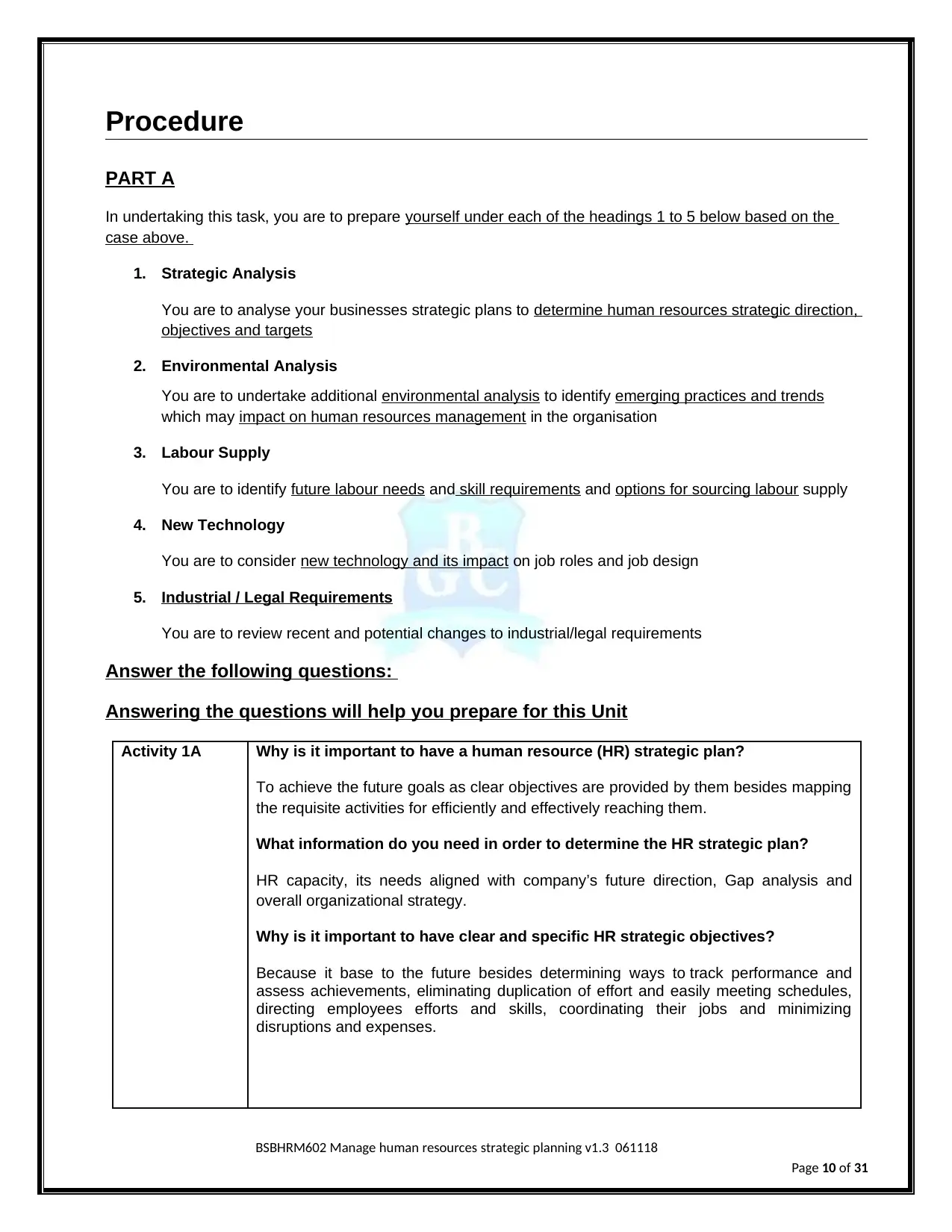
Procedure
PART A
In undertaking this task, you are to prepare yourself under each of the headings 1 to 5 below based on the
case above.
1. Strategic Analysis
You are to analyse your businesses strategic plans to determine human resources strategic direction,
objectives and targets
2. Environmental Analysis
You are to undertake additional environmental analysis to identify emerging practices and trends
which may impact on human resources management in the organisation
3. Labour Supply
You are to identify future labour needs and skill requirements and options for sourcing labour supply
4. New Technology
You are to consider new technology and its impact on job roles and job design
5. Industrial / Legal Requirements
You are to review recent and potential changes to industrial/legal requirements
Answer the following questions:
Answering the questions will help you prepare for this Unit
Activity 1A Why is it important to have a human resource (HR) strategic plan?
To achieve the future goals as clear objectives are provided by them besides mapping
the requisite activities for efficiently and effectively reaching them.
What information do you need in order to determine the HR strategic plan?
HR capacity, its needs aligned with company’s future direction, Gap analysis and
overall organizational strategy.
Why is it important to have clear and specific HR strategic objectives?
Because it base to the future besides determining ways to track performance and
assess achievements, eliminating duplication of effort and easily meeting schedules,
directing employees efforts and skills, coordinating their jobs and minimizing
disruptions and expenses.
BSBHRM602 Manage human resources strategic planning v1.3 061118
Page 10 of 31
PART A
In undertaking this task, you are to prepare yourself under each of the headings 1 to 5 below based on the
case above.
1. Strategic Analysis
You are to analyse your businesses strategic plans to determine human resources strategic direction,
objectives and targets
2. Environmental Analysis
You are to undertake additional environmental analysis to identify emerging practices and trends
which may impact on human resources management in the organisation
3. Labour Supply
You are to identify future labour needs and skill requirements and options for sourcing labour supply
4. New Technology
You are to consider new technology and its impact on job roles and job design
5. Industrial / Legal Requirements
You are to review recent and potential changes to industrial/legal requirements
Answer the following questions:
Answering the questions will help you prepare for this Unit
Activity 1A Why is it important to have a human resource (HR) strategic plan?
To achieve the future goals as clear objectives are provided by them besides mapping
the requisite activities for efficiently and effectively reaching them.
What information do you need in order to determine the HR strategic plan?
HR capacity, its needs aligned with company’s future direction, Gap analysis and
overall organizational strategy.
Why is it important to have clear and specific HR strategic objectives?
Because it base to the future besides determining ways to track performance and
assess achievements, eliminating duplication of effort and easily meeting schedules,
directing employees efforts and skills, coordinating their jobs and minimizing
disruptions and expenses.
BSBHRM602 Manage human resources strategic planning v1.3 061118
Page 10 of 31
Paraphrase This Document
Need a fresh take? Get an instant paraphrase of this document with our AI Paraphraser
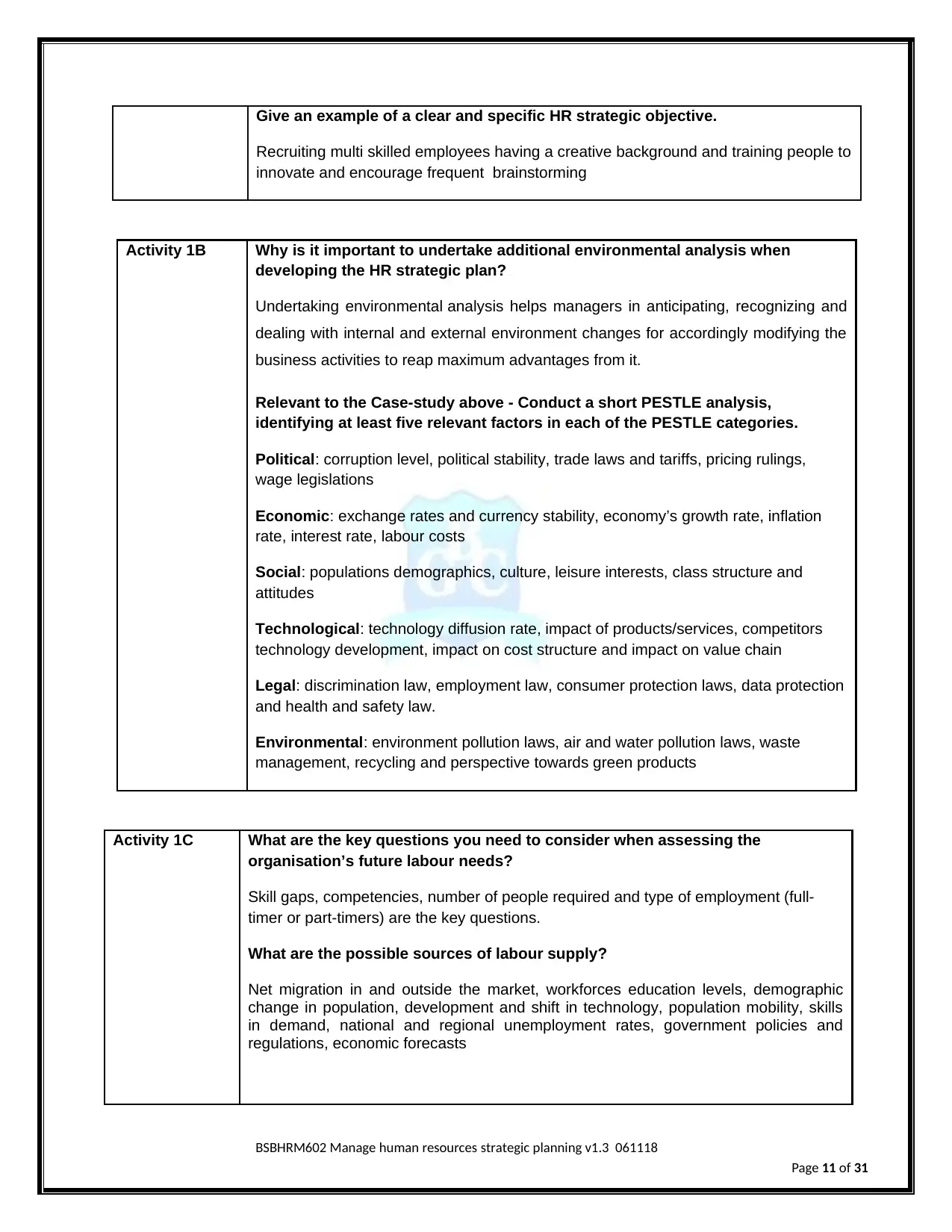
Give an example of a clear and specific HR strategic objective.
Recruiting multi skilled employees having a creative background and training people to
innovate and encourage frequent brainstorming
Activity 1B Why is it important to undertake additional environmental analysis when
developing the HR strategic plan?
Undertaking environmental analysis helps managers in anticipating, recognizing and
dealing with internal and external environment changes for accordingly modifying the
business activities to reap maximum advantages from it.
Relevant to the Case-study above - Conduct a short PESTLE analysis,
identifying at least five relevant factors in each of the PESTLE categories.
Political: corruption level, political stability, trade laws and tariffs, pricing rulings,
wage legislations
Economic: exchange rates and currency stability, economy’s growth rate, inflation
rate, interest rate, labour costs
Social: populations demographics, culture, leisure interests, class structure and
attitudes
Technological: technology diffusion rate, impact of products/services, competitors
technology development, impact on cost structure and impact on value chain
Legal: discrimination law, employment law, consumer protection laws, data protection
and health and safety law.
Environmental: environment pollution laws, air and water pollution laws, waste
management, recycling and perspective towards green products
Activity 1C What are the key questions you need to consider when assessing the
organisation’s future labour needs?
Skill gaps, competencies, number of people required and type of employment (full-
timer or part-timers) are the key questions.
What are the possible sources of labour supply?
Net migration in and outside the market, workforces education levels, demographic
change in population, development and shift in technology, population mobility, skills
in demand, national and regional unemployment rates, government policies and
regulations, economic forecasts
BSBHRM602 Manage human resources strategic planning v1.3 061118
Page 11 of 31
Recruiting multi skilled employees having a creative background and training people to
innovate and encourage frequent brainstorming
Activity 1B Why is it important to undertake additional environmental analysis when
developing the HR strategic plan?
Undertaking environmental analysis helps managers in anticipating, recognizing and
dealing with internal and external environment changes for accordingly modifying the
business activities to reap maximum advantages from it.
Relevant to the Case-study above - Conduct a short PESTLE analysis,
identifying at least five relevant factors in each of the PESTLE categories.
Political: corruption level, political stability, trade laws and tariffs, pricing rulings,
wage legislations
Economic: exchange rates and currency stability, economy’s growth rate, inflation
rate, interest rate, labour costs
Social: populations demographics, culture, leisure interests, class structure and
attitudes
Technological: technology diffusion rate, impact of products/services, competitors
technology development, impact on cost structure and impact on value chain
Legal: discrimination law, employment law, consumer protection laws, data protection
and health and safety law.
Environmental: environment pollution laws, air and water pollution laws, waste
management, recycling and perspective towards green products
Activity 1C What are the key questions you need to consider when assessing the
organisation’s future labour needs?
Skill gaps, competencies, number of people required and type of employment (full-
timer or part-timers) are the key questions.
What are the possible sources of labour supply?
Net migration in and outside the market, workforces education levels, demographic
change in population, development and shift in technology, population mobility, skills
in demand, national and regional unemployment rates, government policies and
regulations, economic forecasts
BSBHRM602 Manage human resources strategic planning v1.3 061118
Page 11 of 31
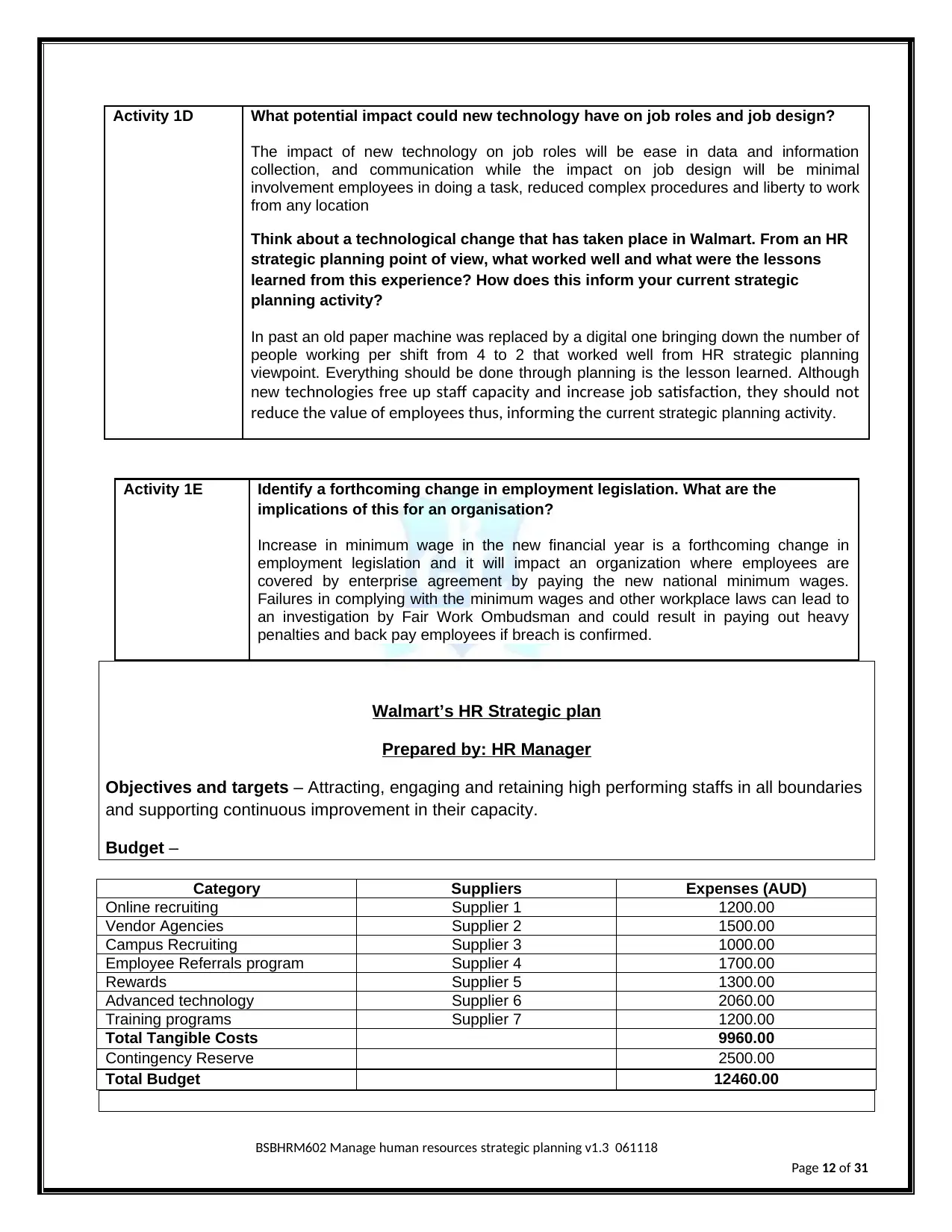
Activity 1D What potential impact could new technology have on job roles and job design?
The impact of new technology on job roles will be ease in data and information
collection, and communication while the impact on job design will be minimal
involvement employees in doing a task, reduced complex procedures and liberty to work
from any location
Think about a technological change that has taken place in Walmart. From an HR
strategic planning point of view, what worked well and what were the lessons
learned from this experience? How does this inform your current strategic
planning activity?
In past an old paper machine was replaced by a digital one bringing down the number of
people working per shift from 4 to 2 that worked well from HR strategic planning
viewpoint. Everything should be done through planning is the lesson learned. Although
new technologies free up staff capacity and increase job satisfaction, they should not
reduce the value of employees thus, informing the current strategic planning activity.
Activity 1E Identify a forthcoming change in employment legislation. What are the
implications of this for an organisation?
Increase in minimum wage in the new financial year is a forthcoming change in
employment legislation and it will impact an organization where employees are
covered by enterprise agreement by paying the new national minimum wages.
Failures in complying with the minimum wages and other workplace laws can lead to
an investigation by Fair Work Ombudsman and could result in paying out heavy
penalties and back pay employees if breach is confirmed.
Walmart’s HR Strategic plan
Prepared by: HR Manager
Objectives and targets – Attracting, engaging and retaining high performing staffs in all boundaries
and supporting continuous improvement in their capacity.
Budget –
Category Suppliers Expenses (AUD)
Online recruiting Supplier 1 1200.00
Vendor Agencies Supplier 2 1500.00
Campus Recruiting Supplier 3 1000.00
Employee Referrals program Supplier 4 1700.00
Rewards Supplier 5 1300.00
Advanced technology Supplier 6 2060.00
Training programs Supplier 7 1200.00
Total Tangible Costs 9960.00
Contingency Reserve 2500.00
Total Budget 12460.00
BSBHRM602 Manage human resources strategic planning v1.3 061118
Page 12 of 31
The impact of new technology on job roles will be ease in data and information
collection, and communication while the impact on job design will be minimal
involvement employees in doing a task, reduced complex procedures and liberty to work
from any location
Think about a technological change that has taken place in Walmart. From an HR
strategic planning point of view, what worked well and what were the lessons
learned from this experience? How does this inform your current strategic
planning activity?
In past an old paper machine was replaced by a digital one bringing down the number of
people working per shift from 4 to 2 that worked well from HR strategic planning
viewpoint. Everything should be done through planning is the lesson learned. Although
new technologies free up staff capacity and increase job satisfaction, they should not
reduce the value of employees thus, informing the current strategic planning activity.
Activity 1E Identify a forthcoming change in employment legislation. What are the
implications of this for an organisation?
Increase in minimum wage in the new financial year is a forthcoming change in
employment legislation and it will impact an organization where employees are
covered by enterprise agreement by paying the new national minimum wages.
Failures in complying with the minimum wages and other workplace laws can lead to
an investigation by Fair Work Ombudsman and could result in paying out heavy
penalties and back pay employees if breach is confirmed.
Walmart’s HR Strategic plan
Prepared by: HR Manager
Objectives and targets – Attracting, engaging and retaining high performing staffs in all boundaries
and supporting continuous improvement in their capacity.
Budget –
Category Suppliers Expenses (AUD)
Online recruiting Supplier 1 1200.00
Vendor Agencies Supplier 2 1500.00
Campus Recruiting Supplier 3 1000.00
Employee Referrals program Supplier 4 1700.00
Rewards Supplier 5 1300.00
Advanced technology Supplier 6 2060.00
Training programs Supplier 7 1200.00
Total Tangible Costs 9960.00
Contingency Reserve 2500.00
Total Budget 12460.00
BSBHRM602 Manage human resources strategic planning v1.3 061118
Page 12 of 31
⊘ This is a preview!⊘
Do you want full access?
Subscribe today to unlock all pages.

Trusted by 1+ million students worldwide
1 out of 31
Related Documents
Your All-in-One AI-Powered Toolkit for Academic Success.
+13062052269
info@desklib.com
Available 24*7 on WhatsApp / Email
![[object Object]](/_next/static/media/star-bottom.7253800d.svg)
Unlock your academic potential
Copyright © 2020–2025 A2Z Services. All Rights Reserved. Developed and managed by ZUCOL.


